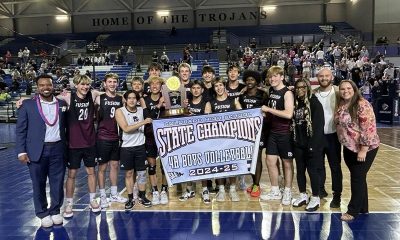Many people have left the sports journalism world in recent decades, but some of them haven’t gone far. Amongst that group is Hannah Taylor (née Withiam), who recently shifted from journalism to a sports public relations role at The Lippin Group.
Before this move (a March promotion and shift to a full-time role following previous time as a consultant), Taylor spent eight years in sports journalism. That included time as a sports reporter and producer at The New York Post, as a managing editor at The Athletic, and (most recently) as senior managing editor at Just Women’s Sports. But she told Awful Announcing by email the time was ripe for her to do something different.
“After working in the sports journalism industry for eight years, I was ready for a new challenge,” Taylor said. “While I will always have a passion for storytelling and the creative process behind bringing a writer’s vision to life, I felt an urge to do something more strategic on the business side of sports.”
Taylor is joining The Lippin Group as an accounts supervisor. She’ll be responsible for new business development and acquisition in the sports industry, in addition to day-to-day client relations work. And she said her journalism background will be crucial to success there.
“By transitioning into PR and communications, I was confident I could bring my learnings from the sports media world to help clients develop successful content, media and brand strategies. Understanding what makes a good story is at the center of our work in PR–whether it’s devising a brand narrative, promoting a campaign or pitching a media story or segment–and that skill has come in handy during this transitional period.”
She said it’s also beneficial that she comes in with experience doing a wide range of things across a broad swathe of publications.
“Each publication I worked for was different in its storytelling focus and approach, which helped me acquire a variety of skills and expand my repertoire as a sports journalist,” Taylor said. “I always say the New York Post was one of the best places I could have begun my sports reporting career because working in that competitive and fast-paced newsroom taught me how to identify a news hook, ask the hard questions and write concisely – all while on tight deadlines.
“The Athletic taught me good feature writing and investigative journalism, while Just Women’s Sports broadened my horizons in content strategy and editorial management since I helped build the startup’s website and newsletter from the ground up.”
Taylor’s last couple of roles specifically focused on women’s sports, and came at bold times for those companies. She said helping The Athletic launch women’s basketball verticals (including with dedicated team beat writers) in 2019 particularly stood out to her.
“Launching The Athletic’s WNBA and women’s college basketball verticals in 2019 was an eye-opening experience. While women’s sports verticals are more commonplace these days, what we did then was largely unprecedented.
“We formed a team of dedicated WNBA writers, including one assigned to each team, bringing the sports beat writing model long associated with men’s sports to a women’s sports league. Instead of dipping our toes in WNBA coverage when convenient or stretching one writer to cover an entire league, as many outlets have done with women’s sports in the past, we dove in headfirst.”
Taylor said a key lesson there was that there was notable interest in the WNBA at that time, even pre-Caitlin Clark, but that there were still many who weren’t really aware of the league.
“This approach allowed us to cover the league the way we felt it deserved and more accurately determine the audience’s appetite for it. Managing these verticals showed me just how much work needed to be done to bring more awareness to women’s sports and ultimately led me to Just Women’s Sports to continue to make a difference in the industry.”
And Taylor’s now hoping to make that difference for women’s sports on the PR front as part of her new role.
“My goal is to take my experience working in women’s sports media and use it to help companies and creators make their mark in the industry. As the business opportunities in women’s sports continue to grow, and companies look to invest and carve out their own lane in the field, driving brand awareness and forging the right connections through strategic media campaigns will be key to their success. That’s where I can come in.
“With the help of The Lippin Group’s wealth of PR experience and relationships, I can support these companies in their publicity efforts and continue to lift up the women’s sports industry as a whole. Even though I’m on the other side of women’s sports media coverage now, I believe I can still play a meaningful role in furthering a mission that will always be important to me.”
On a more specific front, Taylor said she feels her experience from the journalistic side can help her in pitching and coordinating stories from the PR side.
“In PR, I find that my experiences both telling my own stories as a reporter and knowing what goes into assigning and choosing stories for publication as an editor have translated into effective media campaign strategies for clients. When we are promoting new content or a new narrative through earned media, I look at it through the lens of which story angle or piece of content I would be interested in pursuing as a journalist and devise the strategy accordingly.
“I also know what’s going on behind the scenes in a newsroom, such as the pressures of producing for quantity and reaching traffic goals, the editorial process behind bringing a story to publication and the conflicts of the editorial or sports calendar. That mutual understanding allows me to communicate effectively with journalists, helping them achieve their goals while also serving the client’s best interest.”
And she said The Lippin Group (where she previously worked as a consultant before taking this full-time role) stood out as a logical landing spot given their background and history.
“The Lippin Group has decades of experience creating strategic communications campaigns for companies, creators and content in media and entertainment, including sports. As I was looking to make the jump from sports media into PR and communications, melding The Lippin Group’s expertise in this area with my own experience in sports seemed like the perfect fit.
“I learned so much from my colleagues about how to run a successful PR campaign during my time as a consultant, and that has allowed me to hit the ground running now as a full-time employee. We have an opportunity to set ourselves apart in the sports PR industry by combining our skill sets, and I am excited to see what we can accomplish as we work to build out the sports division of the company.
Some of Taylor’s current clients include those focused on sports documentaries and marketing. She said working on documentaries appeals to her thanks to their storytelling nature.
“Sports documentaries have a lot of the same qualities that I love about editorial features. They both tell the human sides of a sports story, offering us a window into the stakes and emotions behind the athletes, games and moments that remind us why sports inspire and appeal to us in the first place. Being a part of sharing these types of stories with larger audiences is what excites me most about working with sports documentary clients.”
Taylor said there are many current documentary opportunities in women’s sports, too, and those documentaries may be a key way to sell those sports to wider audiences.
“It’s encouraging to see many more women’s sports documentaries in production these days because I had always considered the lack of them a microcosm of the issues plaguing women’s sports media. For women’s sports to become more mainstream, their stories need to be more accessible and the stakes need to be clearer to prospective fans, and one of the best mediums for achieving this is the documentary.
“It’s no surprise to me that producers, networks and streaming companies are racing to greenlight women’s sports documentaries because, after years of neglect and hesitation, there are a wealth of stories waiting to be told.”
And there’s interest in those stories. Taylor said the dramatic rises in ratings across women’s sports live games and studio programming discussing those sports show off the opportunities here, which transcend just specific pro leagues.
“We are seeing the exponential growth in women’s basketball and soccer play out before our eyes. For both the WNBA and NWSL in recent years, you saw a catalyst to their surge in fan and business interest – with the popularity of women’s college basketball driving more eyeballs to the WNBA, and the Women’s World Cup and U.S. women’s national team positively influencing the NWSL.
“I see similar dynamics playing out right now with the rise of women’s volleyball, softball and hockey. For volleyball and softball, the college game has created more opportunities at the professional level, including three current pro volleyball leagues in the U.S. and Athletes Unlimited moving to a traditional team-based format for its softball league starting this year. For hockey, fan interest in international competition, especially the storied USA vs. Canada women’s rivalry, has contributed to the steady rise of the PWHL.”
Taylor said there’s a lot that will be needed to keep those sports growing, though. She said that includes everything from media coverage to sponsorships to TV rights deals.
“TV broadcast deals and brand sponsorships are important drivers of growth in women’s sports because they provide leagues and teams with the financial resources to support their players, which in turn creates a better product and drives more attendance and viewership. And at the crux of it all, media coverage keeps the ball moving forward by making women’s sports more accessible so it’s both easier and more appealing to get invested.”
Taylor said mainstream media coverage of women’s sports is crucial to that. And she thinks that’s improved in recent years.
“The arguments I made in this op-ed I wrote for Parity last year about the state of women’s sports media coverage still ring true for me today. In it, I explain why women’s sports must get the mainstream media treatment to show it’s worth investing in and suggest four methods for achieving that status.
“When I joined Just Women’s Sports in 2021, the idea was that if legacy media outlets weren’t going to cover women’s sports properly, we needed to do it ourselves. In the year since I wrote the piece for Parity and stepped away from women’s sports journalism, it has been fantastic to see media outlets creating more jobs, verticals and shows dedicated to women’s sports.”
But Taylor said there’s still a long way to go in normalizing coverage of women’s sports.
“The next step I would like to see the industry take, instead of isolating women’s sports coverage to one writer or one vertical, is to integrate women’s sports into regular coverage with enough resources for output and promotion that will paint an accurate picture of the return on investment. I would also like to see more original women’s sports reporting and storytelling, which requires more time and funding but is so important to creating a healthy media ecosystem and maintaining positive momentum.”



























 |#Shorts
|#Shorts




































